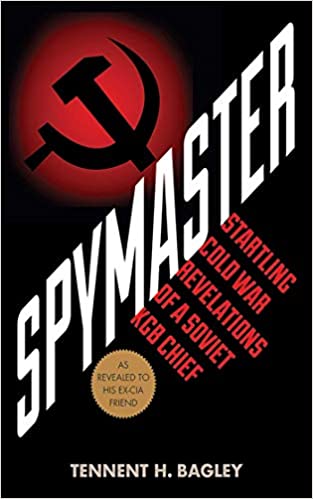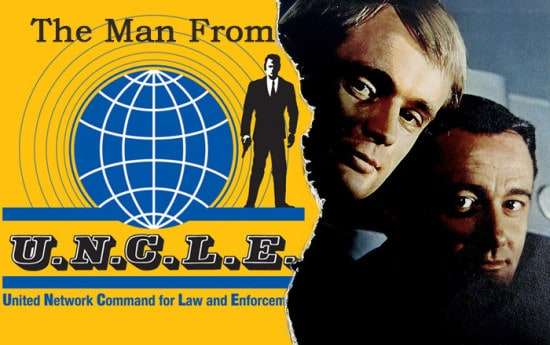Spymaster: Startling Cold War Revelations of a Soviet KGB Chief by Tennant H. Bagley
What's It About?
Ever find yourself pining for the simpler time of the Cold War? Ah, those were the days. There were only two sides: Them vs. Us. Good vs. Evil. Spy vs. Spy.So there’s good news for those of you who liked your war cold: This week (which happens to mark the 54th anniversary of the construction of the Berlin Wall), The Man From U.N.C.L.E hits the big screen. And while the movie—a remake of the popular 1960s TV show—may not be an accurate representation of the world of professional espionage, it does represent a throwback to an era when spies were cool; their martinis were shaken, not stirred; and they all came equipped with awesome gadgets to help them foil their evil nemeses.
The original Man From U.N.C.L.E. TV series ran from 1964-1968, riding a wave of popularity inspired by the King of Pop Culture Spies, James Bond (in fact, Bond’s creator, Ian Fleming, was one of the show’s originators). It followed the adventures of American Napoleon Solo and Russian Illya Kuryakin, agents of the United Network Command for Law and Enforcement, and their battles against the forces of T.H.R.U.S.H. (which stands for Technological Hierarchy for the Removal of Undesirables and the Subjugation of Humanity. Aren’t you glad you asked?).
Look for plenty of style and panache in U.N.C.L.E.’s latest outing, directed by Guy Ritchie (Sherlock Holmes; Lock, Stock and Two Smoking Barrels). The movie will also provide you with more than an eyeful of 60s era fashion—think Mad Men meets MI6. In his review for the Chicago Tribune, Michael Phillips calls the film “a tale of nice suits, pretty sunglasses and actors posing,” and describes Henry (“Superman”) Cavill’s Solo as an “American CIA spy with a sociopath’s devotion to his wardrobe.”
What you shouldn’t look for is a realistic interpretation of the espionage business, a business that’s changed dramatically since the world of Cold-Wars spies of the 60s. “The tradecraft is essentially the same, but technology has transformed the way it’s done,” said Dr. Vince Houghton, historian and curator for the International Spy Museum in Washington, D.C. Houghton told BookTrib that high-tech innovations change how spying is done on a virtual daily basis.
 Also, “cyber has changed things significantly,” Houghton said. “The biggest issue in intelligence collection has always been access. It’s difficult to physically break into a defense firm, for instance, to steal secret plans. Now you don’t have to. If you can break into their networks, you can steal even the most secret information. The more we’re interconnected via the Internet, the more vulnerable we are to this kind of attack.”
Also, “cyber has changed things significantly,” Houghton said. “The biggest issue in intelligence collection has always been access. It’s difficult to physically break into a defense firm, for instance, to steal secret plans. Now you don’t have to. If you can break into their networks, you can steal even the most secret information. The more we’re interconnected via the Internet, the more vulnerable we are to this kind of attack.”
Things also have changed diplomatically since the days of the Aston-Martin with the ejector seat. “The Cold War was a binary system,” Houghton said. “The East and the West. It was much easier to identify the bad guys and the good guys. Now, things are far more complicated. A bad guy in one way—like the Russians and the Chinese—could be an intelligence ally in another, like fighting against ISIS.”
 A far more realistic view of Cold War tensions is heading to theaters in October, when Steven Spielberg’s Bridge of Spies is released. It tells the story of Brooklyn lawyer James B. Donovan (played by Tom Hanks), who is recruited by the U.S. government to venture behind the Berlin Wall. There, he attempts to negotiate for the release of Francis Gary Powers, the pilot of a U-2 spy plane that was shot down over the Soviet Union.
A far more realistic view of Cold War tensions is heading to theaters in October, when Steven Spielberg’s Bridge of Spies is released. It tells the story of Brooklyn lawyer James B. Donovan (played by Tom Hanks), who is recruited by the U.S. government to venture behind the Berlin Wall. There, he attempts to negotiate for the release of Francis Gary Powers, the pilot of a U-2 spy plane that was shot down over the Soviet Union.
The Berlin Wall (or the “Anti-Fascist Protection Rampart,” as it was called by East Berlin authorities), began to fall in 1989, while the actual demolition of the wall took place in 1990. Still, fascination with the Cold War era lingers today, and it seems that we’ll always have an interest in a time when our spies were suave—and the geopolitical problems of the world seemed a bit simpler.
Suggested reading:
Spymaster: Startling Cold War Revelations of a Soviet KGB Chief by Tennant H. Bagley (Skyhorse Publishing, 2015)
 For the first time in print comes the story of real-life Russian spy Sergey Kondrashev, as told to the author, who himself is a veteran CIA operative. Spymaster is the saga of how Kondrashev went from a job at a Russian cultural-relations outfit to landing a key position in counterintelligence.
For the first time in print comes the story of real-life Russian spy Sergey Kondrashev, as told to the author, who himself is a veteran CIA operative. Spymaster is the saga of how Kondrashev went from a job at a Russian cultural-relations outfit to landing a key position in counterintelligence.
Buy this Book!
Amazon





